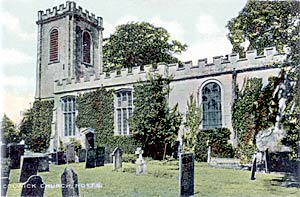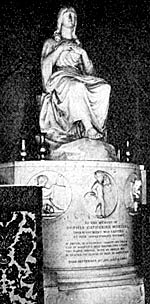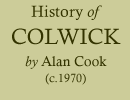< Previous | Contents | Next >
Old Colwick church

Colwick church, c.1910.
When the first church at Colwick was built, or what it was like, no records can tell us, but the Domesday Book tells of a church at Colwick as early as 1086. The next reference to a church, is regarding a memorial window being put in by Nicholas Byron, bearing the wording “Pray for the soul of the worthy man Nicholas Byron, Esq., and of Joan his comfort, who made this window in the year 1496, and the 12th of Henry the 7th.”
The earliest part of the building (now in ruins) still standing is the spacious nave, which was built in the 16th century by Sir John Byron. The building at that period had a spire not a tower, as now. There are no aisles, and the north and south wails are alike, save that the doorway on the north side is now built up. The tall three-light transome windows, and the doorways, have straight-sided arches, with a small curve at the springing, such as met in the domestic buildings of the Tudors. The architecture of the nave is unique, by the fact that it was built at a period following the Dissolution of’ the Monasteries, when all church building was quiescent during the latter part of the reign of Henry Vlll. It is thought that no other example of ecclesiastical work of that period is contained in the county. Also the fact a chantry altar was set up and consecrated within the church at this period, some years after they had been suppressed.

Monument to Sophia Musters in Colwick church, c.1900.
About 1648, Sir John Musters acquired Colwick Hall and “repaired the church at great expense, and the new built the chancel and steeple.” Before doing so, in 1661, as a memorial of the Restoration of the Monarchy, he had the old oak panelling taken from the dining-room in the old hall, and made up into dado seating for the body of the church. The dado consisted of two tiers of moulded raised-mitred panels, with a laid-panel above. There were thirty-two of these laid panels in all, and each one was carved in low relief with Renaissance ornament, consisting of masks and scrollwork. Similar panelling carved with “linen-fold” pattern was used for the choir seats. In 1684, Sir John rebuilt the tower and chancel, also added battlements to the nave to make it match up with the rest of the building. Only one bell was put in the new tower, but four bells were noted in the tower in Edward the Sixth’s time. At the beginning of the 19th century, the chancel windows were replaced by painted glass windows, and these were done by Mrs. Sophia Musters, copying a design painted on a window in the Chapel of New College, Oxford, by Sir Joshua Reynolds. Across the west end of the church stood a deep gallery and underneath this stood a Carolean font. Towards the end of the 19th century, a vestry and organ chamber were added on the north wall of the church. Faculty for this work is dated 27th July 1885.
The churchyard is separated from the hall grounds by a high wall on the south side built of bricks, which correspond with those of the hall buildings. This wall was built in 1885, when John Chaworth Musters, Esq., gave the Parish more land to extend the graveyard to the south and closer to the hall. Plan for this extension is dated March 19th, 1885. Although the graveyard is closed, one or two more burials could still take place in graves already reserved.
Under a Faculty, dated, 15th June 1909, a stained glass window was placed in the south side of the church, in memory of the late Rector, the Rev. Canon W.B. Curran, M.A. Samples of glass, salvaged out of the ruins prove that the window was in fact painted, and not stained.
By 1912, the roof of the church was getting in a bad state, and Mr. Littler, an architect, was called in to give advice and suggested the following: —
- Remove the old lead, sell it, and re-roof the church with new lead — costing about £150.
- Remove the old lead, sell it, and re-roof the church with rock asphalt at a coat of £60. This was subject to a faculty being granted.
- Remove the old lead, re-cast it and add more lead, and replace — this would cost about £200.
After full discussion, the Vestry Meeting decided to adopt the third suggestion. At a later meeting in October 1912, seven tenders for the work were considered, and Mr. Jos. Clark, of Netherfield, who submitted the lowest tender, was accepted. This work, which would have cost £250, was never carried out as in April 1913, the Vestry Meeting decided to rescind the resolution of July 16th, 1912, and to revert to replacing the lead with rock asphalt. A Faculty was applied for, and at the next meeting in May 1913, tenders for the work were accepted and the work was completed at a cost of £258. 11s. 10d.
This made the building serviceable again for a few years, but by 1920 some of the services were being held in the Schoolrooms in wintertime and later in the Church Hall. In March 1924, the down pipes were repaired and the walls pointed. The roof was again repaired to keep the rain out in December 1929. It was closed as being unsafe in March 1936, and on November 20th, 1936, the great principal beam of the roof gave way, bringing down most of the nave roof.
In May, 1937, the Parochial Church Council of Colwick passed the following resolution:
“We the Parochial Church Council of Colwick in the County of Nottingham and Diocese of Southwell, hereby approve the application for a faculty by Colonel Chaworth Musters to purchase the oak panelling in the old church for the sum of £30, and to remove the same and for permitting him to remove the monuments from the Church erected to members of his family and the Window in the east end put in by them. The expenses of procuring this Faculty and all other expenses connected with these removals will be met by Colonel J. N. Chaworth Musters, to whose kindly interest and generosity we owe much, as we do to his ancestors for providing the Rectory and the income of the Rector, writes the Rev. W. S. Hildesley.”
A faculty was granted in September, 1937, to the Nottingham Corporation for the removal of the Byron monuments to the Cloisters of Newstead Abbey. They consisted of a table tomb of Sir John Byron, 1567, a canopied tomb of Sir John Byron and his wife Alicia, 1609, and a wall monument to Sir John Byron and his wife, 1623.
In 1940, John Taylor & Co., of Loughborough, removed the bell from the tower. The bell weighed just over 5cwts and was inscribed “Thomas Mears of London Founder 1825 — Thomas Horseley, Richard Clarkson — Churchwardens.”
They also removed a cast-iron wall safe, which had inscribed on the door “Rev. Peter Thoroton, Rector, W. Streetly and W. Porter, Churchwardens, Colwick, AD 1817”. Apart from removing the roof timbers and some of the floor, this was the last time that the Parish had cause to enter the ruins.
